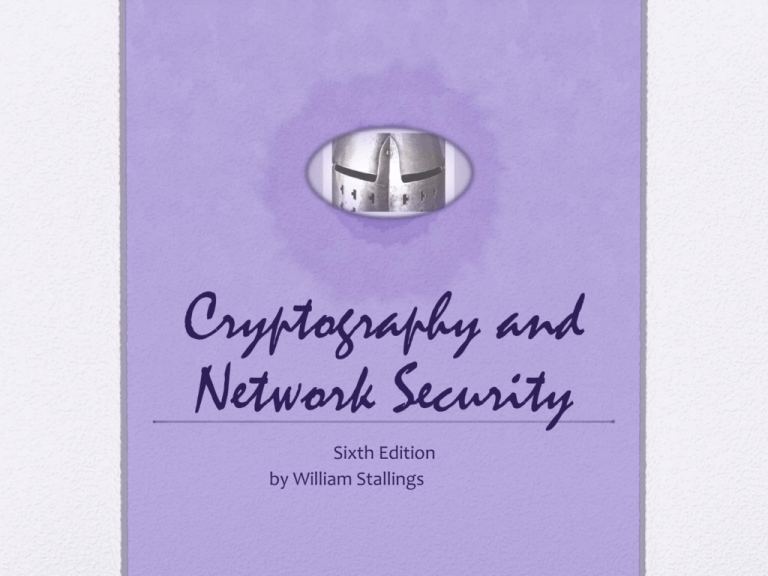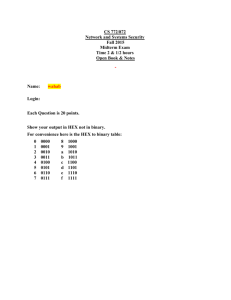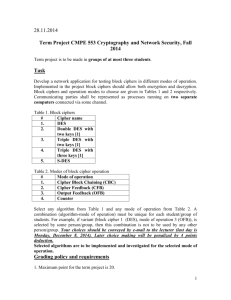William Stallings, Cryptography and Network Security 5/e
advertisement

Cryptography and Network Security Sixth Edition by William Stallings Chapter 6 Block Cipher Operation “ Many savages at the present day regard their names as vital parts of themselves, and therefore take great pains to conceal their real names, lest these should give to evil-disposed persons a handle by which to injure their owners.” — The Golden Bough, Sir James George Frazer Double DES Meet-in-the-Middle Attack The use of double DES results in a mapping that is not equivalent to a single DES encryption The meet-in-the-middle attack algorithm will attack this scheme and does not depend on any particular property of DES but will work against any block encryption cipher Triple-DES with Two-Keys • Obvious counter to the meet-in-the-middle attack is to use three stages of encryption with three different keys • This raises the cost of the meet-in-the-middle attack to 2112, which is beyond what is practical • Has the drawback of requiring a key length of 56 x 3 = 168 bits, which may be somewhat unwieldy • As an alternative Tuchman proposed a triple encryption method that uses only two keys • 3DES with two keys is a relatively popular alternative to DES and has been adopted for use in the key management standards ANSI X9.17 and ISO 8732 Multiple Encryption Triple DES with Three Keys • Many researchers now feel that three-key 3DES is the preferred alternative Three-key 3DES has an effective key length of 168 bits and is defined as: •C = E( K3, D( K2, E( K1, P))) Backward compatibility with DES is provided by putting: •K3 = K2 or K1 = K2 • A number of Internet-based applications have adopted three-key 3DES including PGP and S/MIME Modes of Operation • A technique for enhancing the effect of a cryptographic algorithm or adapting the algorithm for an application • To apply a block cipher in a variety of applications, five modes of operation have been defined by NIST • The five modes are intended to cover a wide variety of applications of encryption for which a block cipher could be used • These modes are intended for use with any symmetric block cipher, including triple DES and AES Electronic Codebook Mode (ECB) Criteria and properties for evaluating and constructing block cipher modes of operation that are superior to ECB: • Overhead • Error recovery • Error propagation • Diffusion • Security Cipher Block Chaining (CBC) Cipher Feedback Mode • For AES, DES, or any block cipher, encryption is performed on a block of b bits • In the case of DES b = 64 • In the case of AES b = 128 There are three modes that make it possible to convert a block cipher into a stream cipher: Cipher feedback (CFB) mode Output feedback (OFB) mode Counter (CTR) mode s-bit Cipher Feedback (CFB) Mode Output Feedback (OFB) Mode Counter (CTR) Mode • Hardware efficiency Advantages of CTR • Software efficiency • Preprocessing • Random access • Provable security • Simplicity Feedback Characteristics of Modes of Operation XTS-AES Mode for Block-Oriented Storage Devices • Approved as an additional block cipher mode of operation by NIST in 2010 • Mode is also an IEEE Standard, IEEE Std 16192007 • Standard describes a method of encryption for data stored in sector-based devices where the threat model includes possible access to stored data by the adversary • Has received widespread industry support Tweakable Block Ciphers • XTS-AES mode is based on the concept of a tweakable block cipher • General structure: • Has three inputs: plaintext A symmetric key tweak P K T A A • Tweak need not be kept secret • Purpose is to provide variability Produces a ciphertext output C Tweakable Block Cipher XTS-AES Operation on Single Block XTS–AES Mode Summary • Multiple encryption and triple DES • Double DES • Triple DES with two keys • Triple DES with three keys • Electronic code book • Cipher block chaining mode • Cipher feedback mode • Output feedback mode • Counter mode • XTS-AES mode for block-oriented storage devices • Storage encryption requirements • Operation on a single block • Operation on a sector








